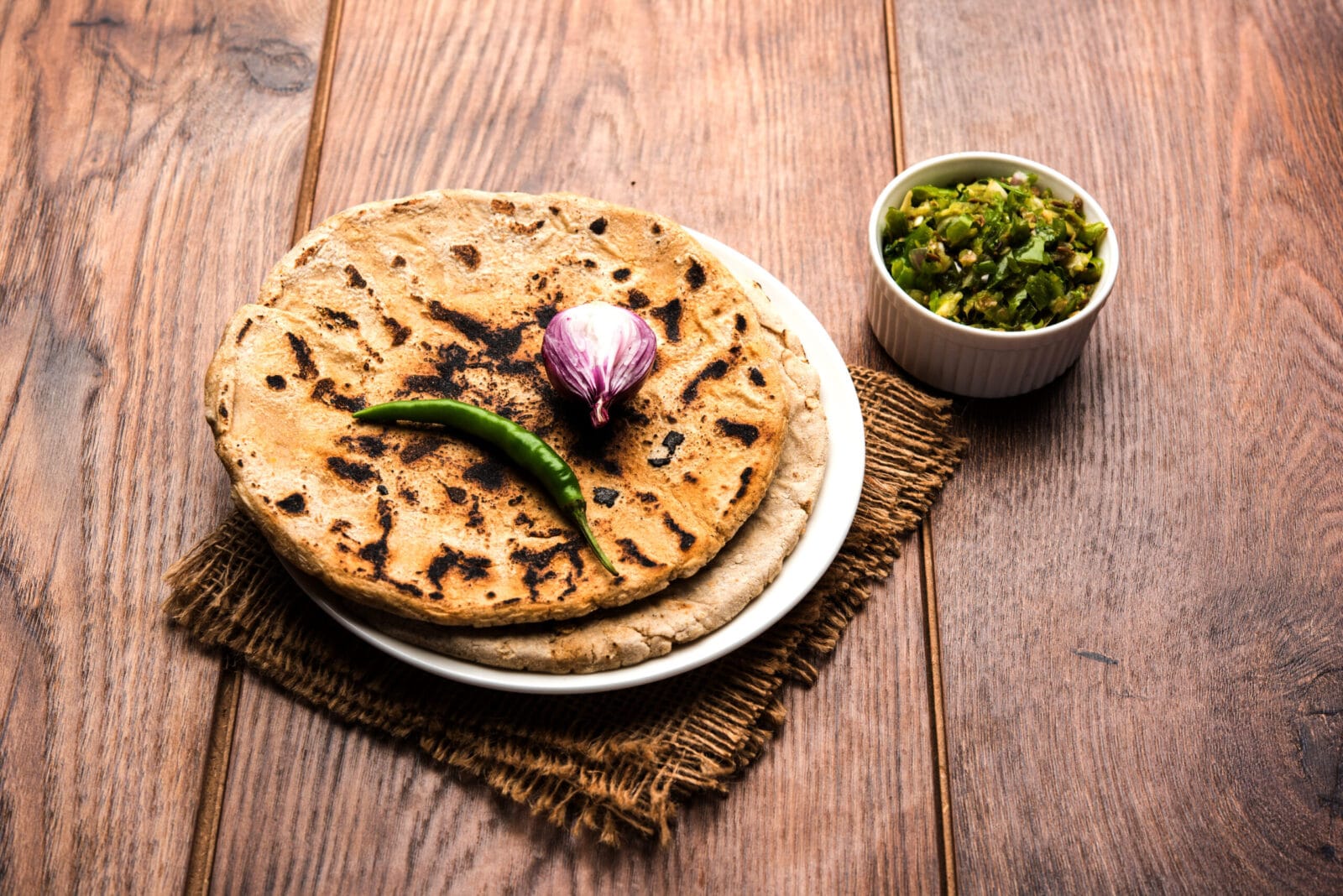Our tour guides share their favourite breads made from gluten-free grains available in the city.
Looking for breads made with gluten-free grains in Dubai? Indian supermarkets in the city are a great starting point because they stock gluten-free grains and some Indian restaurants actually offer traditional gluten-free flatbreads on their menu.
Our tour guides Farida and Noorin share delicious recipes that you can make at home using gluten-free grains or find the ready-made rotis at selected restaurants in the city. Tune in to the episode using the player below (or read the transcript) to here all about these grains and where to find them. Scroll down below for the list of flatbreads shared on the podcast that are made with gluten-free grain, supermarket and restaurant recommendations and Noorin’s legendary lentil dosa recipe!
Links to all the good stuff on gluten-free grains shared by our teammates on the podcast!
- You can purchase all the mentioned grains or their flours at Al Adil Supermarkets.
- Check out Noorin’s dosa making skills on Instagram and her recipe for lentil dosas.
Want more of our scrumptious podcast episodes? Feast on our main podcast page here!
Subscribe on: Apple Podcast App | Spotify (available on AppStore and Google Play) | Google Play Music (currently supported only for listeners in US/Canada) | Anghami
1. Finger Millet: Ragi or Nachni
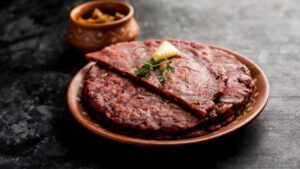
Ragi Roti – Finger Millet Flat Bread
Noorin, our spice souk tour guide, shares that “ragi is finger millet and a much-needed addition to a gluten-free diet that fills the void of your wheat rotis or parathas.
You make it just like your rotis, mix the flour in simmering, warm water. Now that’s the difference when you’re kneading this dough, you’re not adding water to the flour. You’re actually boiling the water, simmering it, and then adding the flour to the water, mixing it up, like you would porridge, make it into a nice, thick mush and switch off the stove.
Take it off on a flat surface, knead it like you would your normal, regular wheat flour, and then roll it out into your normal parathas or rotis.”
Get more tips on how to roll out this “moody” roti by tuning in to the podcast or check out the transcript here. Or if you’d rather outsource the operation, try ragi roti at Shri Krishna Bhavan in Karama!
2. Pearl Millet: Bajra
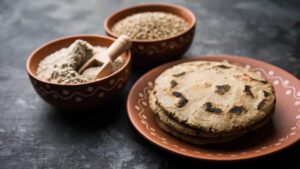
Bajra Roti – Pearl Millet Flat Bread
Farida, our GM and food tour leader, shares that bajra or pearl millet “grows extensively” in India, “especially in the state of Rajasthan. And it’s a beautiful grain to grow if you’re living in a desert climate because it has a short growing season, it doesn’t need the soil to be too fertile and it needs very, very, little moisture. The great thing about bajra rotis or pearl millet rotis, as well, is that they are considered to help with cooling down the body. So can you imagine how great that would be in a city like Dubai during the summer, as well?”
Hear her story of an emperor in medieval India who “almost lost the entire kingdom of India for a handful of pearl millet” on the podcast or check out the transcript here.
Try bajra rotis with jaggery and ghee at Manvaar Restaurant.
3. Sorghum: Jowar
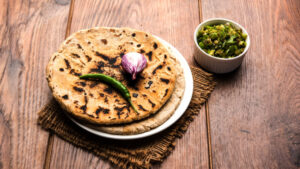
Jowari Roti – Sorghum Flour Flat Bread
4. Lentil Dosa: Adai *Recipe Included!*
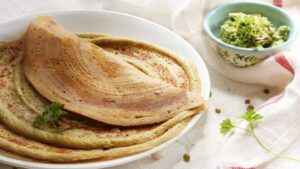
Adai or Lentil Dosa
Noorin’s Recipe for Lentil Dosa
Prep time: 10 mins
Cooking time: 2 mins per dosa
Soaking time: Min 4 hours, preferably overnight
Ingredients
- ½ cup urad dal or split and skinned black gram
- ¼ cup green gram or mung beans
- ¼ cup yellow lentils or yellow moong dal
- 1 cup quinoa
- 7-8 grains methi or fenugreek seeds
- Salt as needed
- ½ to ¾ cup water or as needed for the batter
- oil or ghee – ½ to ¾ tsp for each dosa
Instructions
Preparation for mixed lentil dosa:
- Wash the lentils, quinoa, and fenugreek in a large bowl till the water runs clear. Soak this for a minimum of 4 hours, but best to keep it soaked overnight.
- Drain the water completely, and place the lentils-quinoa mix in the blender and blend with enough water to make a thick smooth batter.
Making the dal dosa:
- Heat a dosa tawa or flat pan on a medium flame.
- When the pan is hot enough, pour a ladle-full of batter in the center and spread the batter in a circular motion with the back of the ladle, across the pan starting from the center.
- The thickness of the dosa will depend on how much you spread the batter. The farther you spread it, the thinner the dosa.
- Drizzle ghee or oil around the edges and on top of the dosa and cook this on medium heat. Place a lid over the top.
- When the dosa is cooked when you notice the edges getting brown spots. Scrape the
dosa from around the edges, fold and serve - You don’t need to flip to cook on the other side as the steam from placing the lid cooks both sides simultaneously.
- Serve the dosa with coconut chutney, pickle, or potato bhaji.
Not a fan of audio? Here’s the show transcript for you to read!
- 4 Gluten-free grains in Indian Cuisine
Arva: This show is brought to you by Dubai’s most gluttonous food tour company, Frying Pan Adventures and you’re listening to Deep Fried.
Hey there, I’m your host. Arva Ahmed and thanks for joining me on the show that’s inspired by flavors of the East. This podcast celebrates the Old World flavors that we as storytellers, content, creators and food tour guides with Frying Pan Adventureshave discovered in Dubai.
And one of those discoveries, or shall I say, series of discoveries is bread. Because we’ve got so many cultures living here it’s only natural that the city’s breadbasket reflects that diversity. And rather than eat through that basket all in one episode, we’re going to explore different bread themes over time. Now what we’re going to tear a piece off today is gluten-free bread from the Indian subcontinent.
Now, this is not bread that is specifically made and marketed to be gluten-free, but rather breads that have been made across Indian villages that have always historically and unconsciously been gluten-free, from times when our diet of grains was far more varied than what it’s become today, which is pretty wheat centric.
So, with me for this conversation are two of my fellow Indian Frying Pan teammates. The first is Farida Ahmed, my very own sister, our GM and food tour guide who’s best known for her tours of Little India, her photogenic memory for food trivia and her survival skills around deathly amounts of spice.
Hey Farida, thanks for joining!
Farida: Hi, thanks for having me back!
Arva: And the second speaker who’s on the line today is Noorin Ansari, our food tour guide whose claim to fame are both, her tours of our local spice souk and her home cooking, where she’s known to challenge traditional Indian recipes with some unexpected, but delicious twists.
Hey Noorin, welcome back to the show!
Noorin: Hey, thanks for having me back!
Arva: Well, thanks for joining me, both of you ladies.
I would love for each of you to share your favorite gluten-free breads from the Indian subcontinent, and maybe tell us how you can make them or where you can find them in the city.
Noorin, why don’t you kick us off?
1. Finger Millet: Ragi or Nachni
Noorin: Alright.
Now, as much as gluten-free has become a buzzword a while back, along with keto and intermittent fasting—don’t get me wrong, I’m a strong believer of both just, way before they started trending—gluten-free is also a lifestyle commitment, especially for those suffering from severe gut-related issues.
People suffering from intense intolerances and allergies, especially because of IBS or Hashimoto’s can not even dream of regular breads or cakes, danishes or pizzas, or your regular pasta. Takeout food becomes a nightmare to order, because what’s easy to order without gluten? I know this because my husband faces the same issues.
But imagine not being able to eat your naan with your eight-hour slow-cooked paya or trotters, or to eat your eggs with a flaky paratha and this is an ode to my favorite anda paratha spot back when our tours were alive.
Arva: Life is not worth living.
Noorin: It isn’t, oh my God. It isn’t.
As an alternative solution to rotis, I developed the ragi roti recipe. Now, ragi is finger millet and a much-needed addition to a gluten-free diet that fills the void of your wheat rotis or parathas.
You make it just like your rotis, mix the flour in simmering, warm water. Now that’s the difference when you’re kneading this dough, you’re not adding water to the flour. You’re actually boiling the water, simmering it, and then adding the flour to the water, mixing it up, like you would porridge, make it into a nice, thick mush and switch off the stove.
Take it off on a flat surface, knead it like you would your normal, regular wheat flour, and then roll it out into your normal parathas or rotis. Now, when you’re cooking this on the stove, you’re only using a damp cloth to cook your rotis, you do not need ghee or oil. It even fluffs up like a nice roti.
And once it’s done, you can add your dollop of ghee or butter to it and enjoy it, just like you would a regular paratha.
Arva: Yeah, ragi is definitely one of the most nutritious grains that you can have. My mum, who is a nutritionist, has ragi porridge for breakfast in the morning and she raves about the iron content of ragi, but she would also make rotis for us in a similar way using ragi and I’ll be honest it is quite fiddly because that dough kind of breaks apart. It doesn’t stick together as firmly, as when you’re rolling out chapatis.
So you have to be very, very careful with it but it actually tastes really delicious. It’s sort of like when you have multi-grain bread versus white bread, there’s many more levels of flavor in multi-grain bread, it’s the same, I feel, with ragi.
Noorin: I think it’s quite earthy as well.
Arva: Yes, earthy is the right word.
Farida: Correct.
Noorin: It’s so rich in fiber and calcium. It’s a great grain to switch to for weight loss as well. And it’s also a great alternative to rice and wheat, which means diabetics can benefit from this too.
Farida: Hey Noorin, quick question is nachni flour the same as ragi.
Noorin: It is nachni, correct.
Farida: I’ve always wondered that.
Arva: And it’s interesting, it’s called finger millet, right, in English.
Noorin: Correct
Arva: It’s interesting when you look at the cereal, finger millet, it’s actually got, I mean, it’s called finger millet because it’s got these five fingers…
Farida: …fingers to it.
Arva: …reaching out at you, so that’s the reason why it’s called finger millet.
Farida: And I think some places in South India, I think I’ve seen this in some of the restaurants, Arva, that we’ve been to in Hyderabad. On the menu, they’ll actually have what they call the ragi ball. So, it’s literally a ball-shaped, I want to say, bun or bread made from ragi.
Arva: Yes, you even have laddoos made out of ragi.
Farida: Yes.
Noorin: That’s correct.
Arva: I remember that during my pregnancy, that was something that was recommended as a very nutritious thing to have.
Noorin: Arva, you are right, ragi or any gluten-free flour is so moody. And after several, several attempts of experimenting with this, I figured out that you have to cook the flour in the water and that’s how you get the malleability, so you get it nice and stretchy.
It actually looks like the purple maize tortillas when they’re cooked. They’re nice and very rich purple in color, so it’s really pretty to eat as well.
Arva: That sounds delicious. Farida, what’s your gluten-free pick?
2. Pearl Millet: Bajra
Farida: Okay, so, one of my favorites has got to be the rotis made out of pearl millet, or bajra.
Now this grain, in India, grows extensively, especially in the state of Rajasthan. And it’s a beautiful grain to grow if you’re living in a desert climate because it has a short growing season, it doesn’t need the soil to be too fertile and it needs very, very, little moisture.
The great thing about bajra rotis or pearl millet rotis, as well, is that they are considered to help with cooling down the body. So can you imagine how great that would be in a city like Dubai during the summer, as well? Pearl millet is also an excellent source of iron, protein, folic acid and fiber. It helps check anemia, and as with ragi, it can help with weight loss.
In addition to that, it also helps to flush out toxins and makes you feel fuller. So, you know what mum would say a higher satiety value. So you can actually feel fuller by eating fewer rotis. If you’re an athlete, this is great for endurance as well, good for your bones, good for your skin eyes, you know, all of that great stuff just boils down to this one millet.
As with ragi you would need to knead bajra using warm to hot water, but unlike ragi, you don’t have to put the grain into the hot water. You just use warm water and knead it into the bajra dough. Unlike regular rotis that use wheat, normally what mom does is she kneads the dough and allows it to rest for a bit.
But with grains that do not contain gluten to help them stand up or give them structure…
Arva: …bind together, yeah…
Farida: …exactly, you would have to knead the dough and immediately roll out the rotis. And then as with your regular rotis, you take a flat griddle or a flat pan, and you just bake the roti on that. You can use a slightly damp cloth to kind of press down on the roti as you’re making it to make sure that it puffs up and then you finish it off with ghee.
Arva: What are the traditional pairings with bajra when you look across Indian villages, other than just daal, I mean, what else would you think are the classic pairings?
Farida: I’m going to, I’m going to tell you that, but before this, I’m also going to share a story that I love around bajra and this is from the state of Rajasthan. And this is a story that, it’s an actual story, that happened somewhere around 1544.
There was the Muslim ruler, Sher Shah Suri, and he decided to go up against the King of Marwar, this is Raja Maldev. And when Sher Shah Suri got to Rajasthan, initially, his army was hard-pressed to find food, but the Rajasthani army was doing absolutely fine because they survived on this hard grain, bajra, that kept them going. Unfortunately, they eventually lost the war, but Sher Shah Suri admitted that he almost lost the entire kingdom of India for a handful of pearl millet. So that is how important that grain is in that state.
Common pairings. Now, I’ve had bajra roti at a restaurant in Dubai called Manvaar, and the way they like to serve it is in a dish called Bajra Gud Manvaar. Bajra roti which is slathered in ghee and on top of that, they will crumble pieces of gud or jaggery, which is unrefined cane sugar.
It is absolutely delicious because you have this nuttiness, this earthiness coming from the pearl millet bread, topped off with this clarified butter, into which the gud slowly, slowly melts. It is absolutely delicious.
At home, we’ve had bajra roti. My mum actually makes it during certain religious times and we would pair that, not really with daal, but with a green leafy vegetable, it could even be spinach, it could be cholai ki bhaji or amaranth, or even simply fenugreek leaves.
Arva: Fantastic, okay, so we’ve done bajra, which is pearl millet, ragi, which is finger millet and these two are available at..?
Noorin: At Adil. If you want to get just the flour, you can find this at Adil Supermarket. So bajra would go under pearl millet and ragi goes with the name of nachni atta.
Arva: And it’s interesting cause, again, like we said earlier, now the world has—is obviously—actively seeking out gluten-free breads, but these have been breads that have historically been made over time and often I feel like they’re considered village breads the way that barley, for example, way back in time, when you rewind back to Mesopotamia, might’ve been considered the more peasant bread compared to some of the richer, fluffier wheat, refined wheat breads.
Farida: And, you know, you can find a lot of these flours at some specialty supermarkets around the city, but at Al Adil you will find them at next to nothing prices.
And Arva you’re also right that today and for the longest time, these have always been considered as peasant breads and that’s because during the 1970s, especially in India, we had the Green Revolution where wheat became a status symbol, almost an elitist product. So nobody wanted to be eating bread made from any other grains because that’s symbolized that you hadn’t made it to the higher crust of society.
Arva: Very interesting. Alright, we are going to continue tucking into this gluten-free bread basket, but first let’s take a quick digestive break.
…and we are back to this gluten-free bread episode of Deep Fried.
We’re specifically focusing on some of the breads in India that have historically been made with grains that are gluten-free. We’re here with Noorin Ansari and Farida Ahmed, two of our Indian teammates at Frying Pan Adventures and Farida, you are up next.
Tell us what are we going to be tucking into?
3. Sorghum: Jowar
Farida: So this is a roti that I did not much appreciate growing up when mum made it. I always found it much harder in texture compared to the regular soft rotis. But I think with time it sort of grew on me, jowari ki roti or sorghum, which like bajra is a grain that is very rich in fiber, it’s good for people who suffer from diabetes, high in magnesium and iron, it can even help to lower BP and cholesterol.
As with ragi that Noorin spoke about earlier and bajra that I mentioned, you would need to knead the dough with hot water and roll right after kneading to avoid that moisture being lost. So really once you get the hang of kneading that dough and rolling out those little disks, it gets much, much easier.
With jowar some people do prefer to use a rolling pin but traditionally, you would actually just form these little balls of dough, pat them with your hand and then just keep flattening them before baking on a hot griddle. And sometimes, traditionally, you would actually finish it off directly over an open flame.
Arva: Yeah, that’s what I find with these breads, it’s best to skip the rolling pin because that puts too much pressure and then the bread ends up breaking, but with your fingers, you can actually really manage the pressure to be right.
Farida: It’s an art.
Arva: To your point, these are not doughs that you can store in advance…
Farida: No…
Arva: …so unlike, for example, with chapati dough, you can make a batch and then…
Farida: …wrap it in plastic and put it in…
Arva: …you can wrap it in plastic, put in the fridge and use it the next day. With this, I don’t think you can do it with any of these breads.
Farida: No, because the longer you let these doughs stand, the more moisture they lose and that’s when the cracks begin to develop and then you really can’t do anything with it. You’ve got a wasted batch that you have to throw out, so you have to knead it out right there and then roll it out and bake it right away.
If you want to really liven-up some of these breads, as well, try adding in some green leafy vegetables, like fenugreek leaves, you can even add in onions and I’ve read somewhere that adding a little bit of paneer helps it to bind together even better. I’ve never tried this out…
Arva: Ah, that’s interesting.
Farida: …but you know, this is something I’m probably going to suggest to mum to try because I am not good at working with these doughs.
Arva: I also find that they have a slightly bitter after-taste, these breads do, in addition to what Noorin said, which is they are earthy, but I think they do require a longer cooking time to sort of pull away that rawness and bitterness compared to wheat.
Farida: They do and you have to remember that it’s not going to fluff up like a wheat roti because of the absence of gluten. So if you’re waiting for it to fluff up, you’ll be waiting for a really long time.
In the city, if you want to try sorghum roti or jowari ki roti, the restaurant in Karama called Peshwa that specializes in Maharashtrian cuisine has this on the menu, and on the menu it will be written as Javarichi bhakri.
Arva: Javarichi bhakri, okay.
Farida: And one of the things that I really enjoy jowari ki roti with and this is a very Maharashtrian way to do it, is to have it on the side with this fiery green chili paste, as well as something called zhunka or pithla, which is a porridge sort of thing made from chickpea flour, so completely gluten-free.
It is considered peasant food and it was frowned upon for the longest time. But now I think even people in India would pay to have a simple meal like that, that is so nutritious. And especially during rainy weather. One of my favorite memories…
Arva: I was just gonna say that…
Farida: …do you remember the trip?
Arva: …during the rain, it just tastes better. Mahabaleshwar.
Farida: Mahabaleshwar, we were there with mum. It was you, me and it was my oldest uncle and I don’t know where we were.
I don’t know, all I remember is pouring rain and we pull off the side of the road, this little dhaba or a roadside stall. And we indulged in hot chai, zhunka, we didn’t have the thecha because we valued our stomachs way too much back then and it was…
Arva: The thecha being the green chili paste.
Farida: …the green chili paste.
It was one of the best meals I’ve had and that rain just elevated that experience and I don’t think I will ever, ever forget that even if I lose all my memories.
Arva: Hundred percent agree. It’s just, it’s one of those unforgettable, again, very, very simple rustic meals. And I don’t think it’s impossible to recreate, but thankfully, like you said, Farida, it is available at some of the restaurants here specifically at Peshwa.
I think there’s another place also called….
Farida: …Manisha’s Kitchen?
Arva: Manisha’s Kitchen, yes, that’s right. I don’t know whether they do the roti, but they definitely do zhunka and pithla, which are the gram-flour based porridges.
Alright, Noorin, let’s talk about your next gluten-free bread. What is it going to be?
4. Lentil Dosa: Adai
Noorin: Mine is the daal dosa, a high protein breakfast recipe made with four kinds of lentils that I use. You can use as many lentils as you like. I use the urad daal (peeled black lentils), I use the green moong, the yellow moong, and then I use toor as well. And I’ll soak these all overnight, grind them up the next day. I’ll add four to five pieces of methi seeds, that’s it and that’s good for digestion and that adds to a little bit of fermentation.
Arva: Methi being fenugreek for people who don’t speak Hindi.
Noorin: That’s correct, fenugreek.
Now, if you want extra fermentation in this, you can add quinoa, whole quinoa as well, while you’re soaking the daals. And the next day, this batter is going to triple its size. So make sure you put it in a really big container. I experimented this once and it just kept falling out of the container.
Farida: Did you have a fridge full of batter?
Noorin: I did. It was such, such a horrible accident.
Farida: God, what a nightmare to clean!
Noorin: It was, but I was so impressed with the fermentation. You do not need rice, so this is excellent for diabetics as well because rice is something you should avoid, ideally, because of its…
Farida: …starch and carbs.
Noorin: Absolutely, high starch content.
Now, once you have ground all of this, add a little bit of salt and if you want hing or asafoetida for digestion, and then you make this as your regular dosas, nonstick, flat griddle, and then you spread out the batter and then wait for it to crisp up on one side.
Do not turn it over. In fact, I just place a lid on top. So the top section of the dosa already cooks in its own steam. Once it’s done, immediately eat that with whatever you wish to eat it with. I have actually devoured this with even my non-vegetarian curries, but it goes best with green chutneys or a tomato chutney, which you would have in restaurants like Venus and Saravana Bhavan, that tomato chutney is delicious.
Arva: I would just have it plain slathered with butter.
Farida: Now, Noorin, you make it sound so easy to, like, you know, she’s like, “oh, just make it the way you would a regular dosa. Just pour a dollop into the pan and you know, whirl your hand around.”
Arva: …thinking the same thing. I’m like, it is not that easy to make a regular dosa, but I’ve seen Noorin…
Farida: …her Instagram.
Arva: I was like, I tried something similar a few weeks ago and it was a mess.
Farida: Scrambled dosa…
Arva: So yeah, she definitely, it takes a lot. Exactly. I have made a lot of scrambled dosa.
Farida: …to anyone listening in, it’s really not that easy. Again, I want to say practice makes perfect, but I also think this is one of those things where you have that born leader, natural leader. I think this is, you need to be born with something in your hands that has, you know, those dosa genes.
But Noorin, at least in Tamil Nadu, which is a state in South India, they do have something similar. It is a dosa made with a mix of different lentils that they actually call forgive my pronunciation adai. And traditionally you would eat your adai with a dollop of ghee and a small mound of gud, which I mentioned before is jaggery or unrefined cane sugar.
And unlike a regular dosa, which is made from rice flour, one or two adai is heavy enough to fill you up, but it’s so nutrient-dense and it’s just amazing. It tastes absolutely great.
Arva: Yeah, because obviously a dosa has rice, which feels lighter, and this is just pure lentils, protein-packed, heavy. That sounds really delicious.
Farida: And if you want to try it at a restaurant here in the city, Sangeetha, this is the restaurant that we also feature on our Little India Tour. I know for a fact that they have adai on their menu, but I personally also like to enjoy it with sambar and chutney, as you mentioned, Noorin.
Arva: I love this.
Okay, and hey Noorin, since you’re such a pro at this, what we’re going to need from you is a recipe with some of your secret tips to making the perfect adai or your lentil dosa, but we will also be nabbing a video of how you do this and share this on our Instagram @Frying Pan Adventures. So people can watch the pro at work.
Sound good?
Noorin: Absolutely, I’d love to.
Farida: And you can always call us over since you’re going to be making them anyway, you’re going to need stomachs, so Arva and I volunteer.
Arva: Absolutely.
Noorin: Done, done. I’ll take you up on that offer.
Farida: No, we’re taking you up on it.
Arva: You are, yeah, actually, we’re taking you up on the offer. Yeah, we will be there.
Alright, ladies, you’ve given us a lot of gluten-free food for thought. This was so much fun, thank you for joining me.
We’re going to wrap up our bread basket now, but all the information that you’ve shared on the grains, obviously, Noorin’s delicious recipe for her lentil dosa, all of that and the show transcript is going to be up on our blog at www.fryingpanadventures.com/blog/
And hey, if you enjoyed listening to Deep Fried, please rate review and share the show with your friends and do connect with us over social at Frying Pan Adventures on Instagram and Facebook and Frying Pan Tours on Twitter.
We’ve also shared our speaker’s Instagram handles, Noorin’s, which is @noogoopooand Farida’s, which is @faridaa, in our show notes.
Ladies, thank you so much again for joining us.
Noorin: Thank you Arva.
Farida: Thanks Arva, see you soon.
Arva: Great to have you both and to our dear listener—thank you for tuning in. We’ll be back again next week with another delicious episode of Deep Fried.
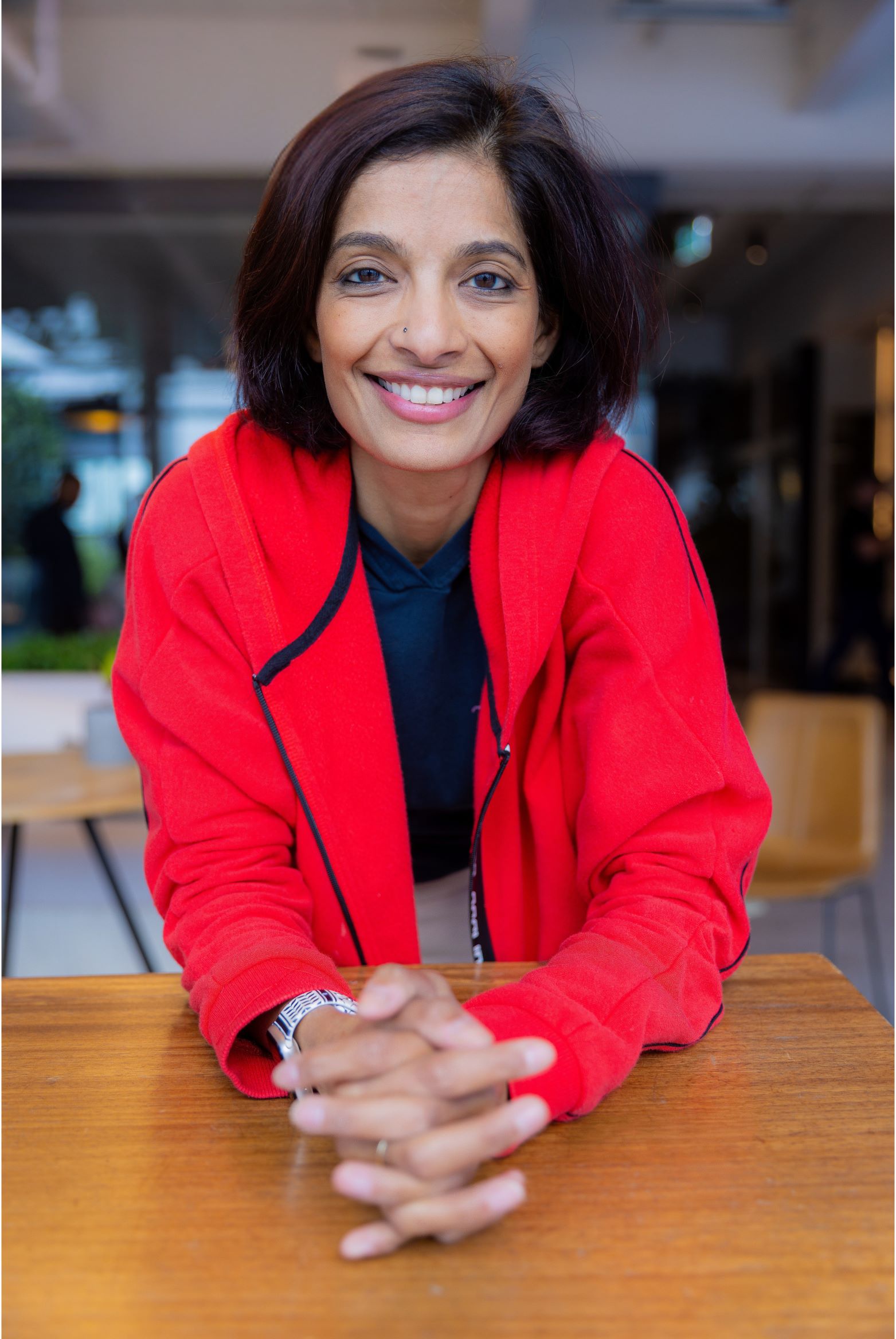
Arva Ahmed is the co-founder of Frying Pan Adventures, Dubai’s first food tour company, and a celebrated food explorer known for uncovering Dubai’s hidden culinary gems. Her expertise in the city’s diverse food scene has been featured in prominent publications such as CNN, Khaleej Times, BBC Travel, The Sun, The Independent and countless more. She also hosts Ditch the Silver on YouTube. Through her immersive tours and storytelling, Arva brings Dubai’s rich flavors and vibrant cultures to life.

